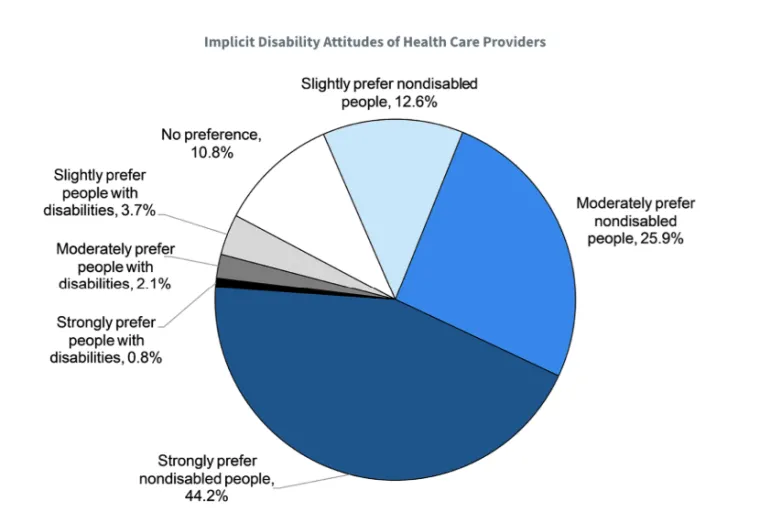The CACTI Blog: Being Normal – What is That? Changing Views on Normalcy in Healthcare

By Andrew Leung, 2023-2024 Undergraduate Certificate In Developmental Disabilities
Author’s Note: This post uses both person-first and identity-first language to address the disabled community. I write this blog post with respect for the diverse perspectives and preferences within the community.
“Do you ever look at someone and wonder, ‘What is going on inside their head?’” This is a famous line of dialogue that was featured in Pete Docter’s 2015 Disney-Pixar film, Inside Out.1 The sound bite was trending on platforms such as TikTok and showed many different videos of individuals behaving wild, atypical, and “quirky”. While the people in the videos were generally praised for being seen as “different”, the same othering sentiment has been used throughout history to push down others and their differing identities, specifically disabled populations. As a nondisabled young adult, I began to question how people separate what is normal from what is abnormal. Society’s views play a large part in determining “normal” through conventions, customs, and routines. In Disability, Society, and the Individual written by Julie Smart, normalcy is a quality that changes with culture and circumstance.2 It can be defined by dividing groups of people into a majority and minority. If one is in the majority, then they could be labeled as normal, and if found in the minority, then they would be described as abnormal. This is directly affected by perspectives that constantly shift within society.2 As a trainee at the Sonoran Center for Excellence in Disabilities, I’ve learned an additional layer of what “normalcy” means. This layer pushes a step further: corresponding the ideas of “normal” to “superior” and “abnormal” to “inferior”. Essentially, part of society has developed an idea that individuals are lesser-than if they do not follow the rest of society’s standards. This highlights a perspective that drives some individuals with disabilities to strive for some sort of “normal” to be accepted by society. Though seemingly not harmful at first glance, this perspective can be damaging to disabled individuals, forcing the idea that they must “fix” themselves to fit in. This ideology has a large influence on healthcare practices which can impact how disabled individuals experience life and receive care.

Figure displaying attitudes and preferences of health care providers working with disabled and nondisabled individuals.2,4
One solution that has been identified to change these perspectives is found within additional educational training modules. These modules can be provided while healthcare workers are first learning how to provide care. In Shields and colleagues’ “Changing Student Health Professionals’ Attitudes toward Disability: A Longitudinal Study”, it was found that there were positive changes in the students’ perspectives when working alongside a young person with disability for twelve weeks. After the three months of volunteering, these students gained a greater level of providing care and confidence in working with individuals with disabilities.5 This is extremely beneficial, considering that in a national survey taken in 2019 - 2020, only 40.7% of outpatient physicians felt very confident that they could provide the same level of quality care to patients with disabilities as to their nondisabled patients.6 By including disability training in education, there can be changes in attitudes, skills, and knowledge among the new generation of healthcare professionals. This can create environments that are inclusive and accessible for disabled individuals and provide care that is competent and equitable.
As a Certificate Student trainee at the Sonoran Center for Excellence in Disabilities, I had the opportunity to learn more about the importance of implementing public policies to encourage the integration of individuals with disabilities into society. Notably, the Affordable Care Act Section 5307 has authorized federal funding to train healthcare providers to work with individuals with disabilities.6 There have been assessments put in place to see whether this training occurs, but assessments have not been collected yet.6 In Dr. Brandy James’ FCM/HPS 408 Disability in Public Health class, we had the opportunity to hear about many similar cases in which the policies are in place, but the actual implementation of those policies is not always practiced. In order for progress to take place, the healthcare system and society at large needs to begin applying solutions that have been demonstrated to be effective. The first step of this is systems and individuals reflecting on their internalized biases. This will foster understanding of why and how our world needs to be more equitable and accessible for everyone.
References
1. Docter, P., & Del Carmen, R. (2015). Inside Out. Walt Disney Studios Motion Pictures.
2. Smart J. (2001). Disability society and the individual. Aspen.
3. Friedman, C. (2020, March 30). Disability attitudes of Health Care Providers. The Council on Quality and Leadership. https://www.c-q-l.org/resources/articles/disability-attitudes-of-health-care-providers/
4. VanPuymbrouck, L., Friedman, C., & Feldner, H. (2020). Explicit and implicit disability attitudes of healthcare providers. Rehabilitation Psychology, 65(2), 101–112. https://doi.org/10.1037/rep0000317
5. Shields, N., Stukas, A. A., Buhlert-Smith, K., Prendergast, L. A., & Taylor, N. F. (2021). Changing Student Health Professionals' Attitudes toward Disability: A Longitudinal Study. Physiotherapy Canada. Physiotherapie Canada, 73(2), 180–187. https://doi.org/10.3138/ptc-2019-0069
6. Iezzoni, L. I., McKee, M. M., Meade, M. A., Morris, M. A., & Pendo, E. (2022). Have Almost Fifty Years Of Disability Civil Rights Laws Achieved Equitable Care? Overview examines 50 years of US disability civil rights laws. Health Affairs, 41(10), 1371-1378.
The CACTI Blog features the voices of our interdisciplinary trainees and Community Advisory Council members as they highlight diverse images of people with disabilities and provide community information and advocacy on disability issues. Check Out The CACTI Blog
